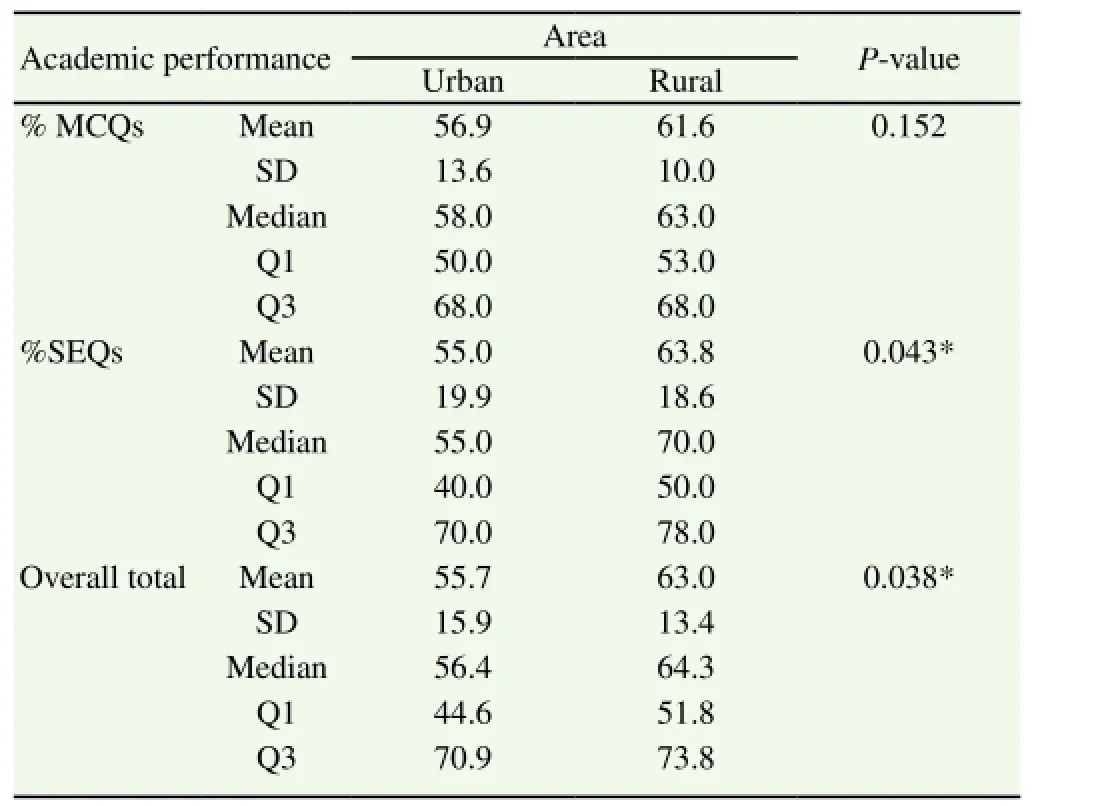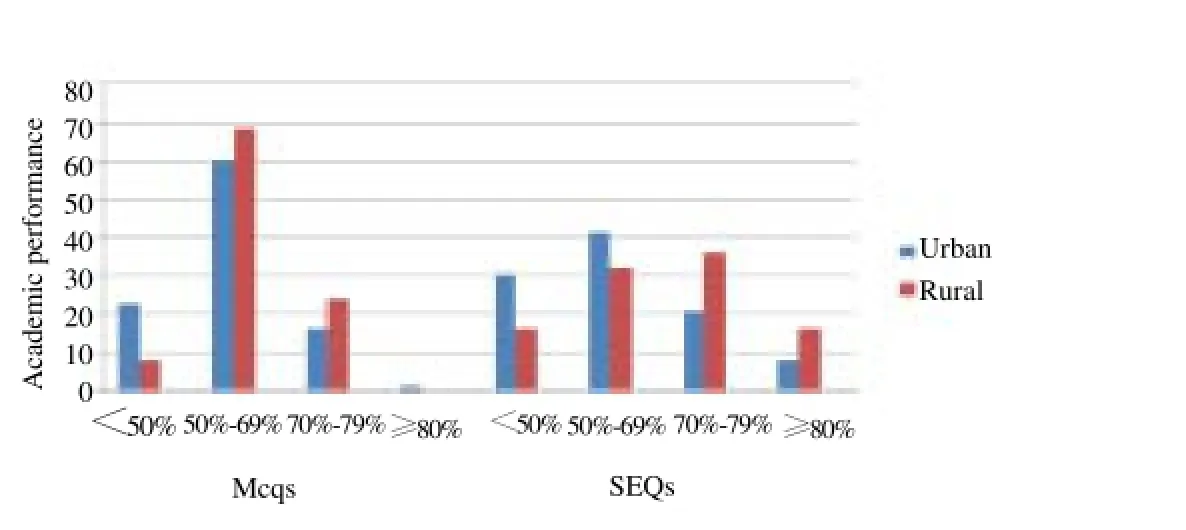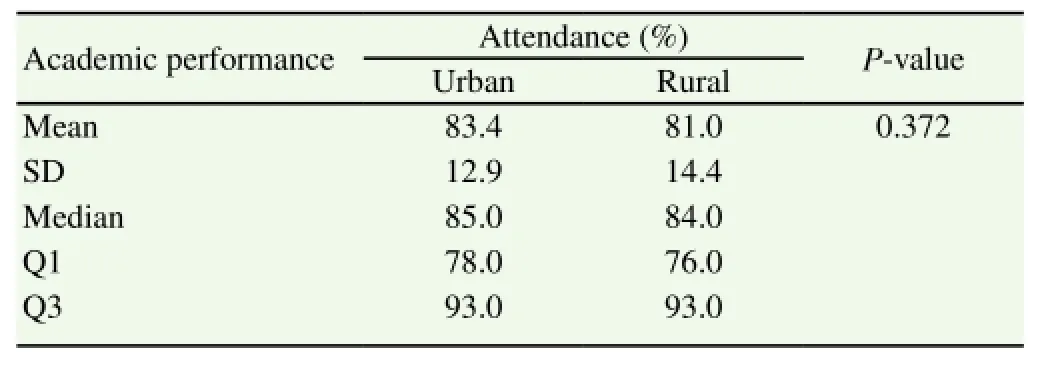Evaluation of the academic achievement of rural versus urban undergraduate medical students in pharmacology examinations
Rizwan Faisal, Laiyla Shinwari, Hajra Mateen
1Pharmacology Department, Rehman Medical College, Peshawar, Pakistan
2Trainee Medical Officer Gynae, Lady Reading hospital, Peshawar, Pakistan
3Pharmacology Department, Rehman Medical College, Peshawar, Pakistan
Evaluation of the academic achievement of rural versus urban undergraduate medical students in pharmacology examinations
Rizwan Faisal1*, Laiyla Shinwari2, Hajra Mateen3
1Pharmacology Department, Rehman Medical College, Peshawar, Pakistan
2Trainee Medical Officer Gynae, Lady Reading hospital, Peshawar, Pakistan
3Pharmacology Department, Rehman Medical College, Peshawar, Pakistan
ARTICLE INFO
Article history:
Received 14 March 2016
Received in revised form
Accepted
Available online
Academic performance Pharmacology Multiple choice questions Short essay questions Urban Rural
Objective: To compare the academic performance of urban and rural students in pharmacology examinations. Methods: It was a comparative study of the academic performance of urban and rural students in pharmacology examinations of the sessions 2014 and 2015. For evaluating the students’ academic performance, urban and rural students were divided into four groups: Group 1: who got < 50% marks in exams; Group 2: who scored between 50%–69% marks; Group 3: who scored between 70%–79% marks; Group 4: who got ≥ 80% marks. Results: When the academic performance of the urban and rural students was compared; significant difference was found with P-value 0.038. Additional comparison revealed insignificant difference in multiple choice questions (MCQs) with P-value 0.152 while significant difference was established in short essay questions (SEQs) with P-value 0.043. Conclusion: The results of the present study showed significant difference between the academic performance of urban and rural students.
1. Introduction
There is consensus that children’s education is one of the key vehicles engendering the development of economies [1]. However, in developing countries the distribution of resources and its consequent effects on rural-urban student performance has remained a grave issue especially in human sciences than physical sciences [2,3]. Despite a rising focus by governments to target rural areas for special assistance, rural-urban disparities in academic performance are still an unresolved problem [2].
A general perception of the comparative inferiority of rural students has prevailed for quite some time. This view implies not only to differences in the academic performance of rural and urban students but also too many other socially desirable outcomes like aspiration, intelligence and aptitude [4]. The concern regarding the academic performance of rural and urban students is not limited to one country but rather it seems to be a global issue [5]. The question whether real educational differences exist between rural and urban students has been a topic of debate since very long time [6]. Recent educational research has established certain differences in the achievements of rural and urban students and also in their higher education successes [4].
Along with other factors, such as availability of technology, resources quality of teachers and gender; geographic location important role in the grooming, motivation and academic performance of the students [7]. A series of studies have suggested the importance of initial schooling and residential environment on the personality and behavior of an individual [8]. Previously a significant difference was found between the academic performance of rural and urban students. But now with the advancement of the technology this difference seems to be vanishing.
Previous studies have shown that performance of rural students
with their urban counterparts showed mixed fashion in results [9]. Felder et al. found that urban students did better in an introductory course than the rural students [10]. Xiato along with his colleagues and Hobbs reported that rural students perform as well as their urban counterparts [6,11].
The rationale of the present study is to somewhat resolve the conflict of better academic performance among rural and urban students. Outcome of the study may form the basis for paying much attention and doing more hard work with the weak group in order to improve their academic performance. The study may be helpful for college’s policy makers to design and implement the policies to improve the students’ performance of the weaker group.
2. Material and methods
It was a comparative study and carried out at Rehman Medical College, Peshawar, after the approval of the ethical commitee of Rehman Medical Institute, Peshawar. The confidentiality of the students was maintained as the names of the students were not disclosed. The consent from the students was taken. 200 Year 03 MBBS students of the sessions 2014 and 2015 were included in the study by universal sampling technique. The course contents included general pharmacology, autonomic nervous system, cardiovascular system, central nervous system, gastrointestinal tract, blood, autacoids, respiratory system, endocrine system and chemotherapeutic agents. All the pharmacology examinations of year 03 MBBS were evaluated and compared on the basis of previous records of fortnightly, end of module, midterm and end of session examinations. The written theory paper consisted of two components: part-I Multiple Choice Questions (MCQs); single best answer type and part-2; Short Essay Questions (SEQs). Structured key was provided to the examiners in order to eliminate the bias when the papers were evaluated.
For evaluating the academic performance of male and female students, they were divided into 4 groups: Group 1: who got < 50% marks in exams; Group 2: who scored between 50%–69% marks; Group 3: who scored between 70%–79% marks; Group 4: who got ≥80% marks.
Statistical analysis: The data were entered and analyzed by using SPSS 20.0. Data for MCQs and SEQs marks was described by using mean, SD, median, IQR, frequency and percentages. Three way ANOVA was used to see for any interaction effect of gender, residential status and attendance on exam performance but was found to be insignificant. Then the only main effects were compared by using Mann Whitney U test. Tukey’s test was used for post hoc analysis. Chi-square analysis was used to see any difference among marks categories for locality. P-value of ≤ 0.05 was considered significantly different.
3. Results
Total 200 MBBS students of the sessions 2014 and 2015 were enrolled in the study. When the academic performance of the urban and rural students was compared; significant difference was found with P-value 0.038. When further comparison was done; insignificant difference was found in MCQs with P-value 0.152 while significant difference existed in SEQs with P-value 0.043 (Table 1). In MCQs, 22.9% urban students scored < 50% marks, 60% were found in the range of 50%–69%, 16.0% got marks between 70%–79% and 1.1 scored ≥ 80% marks. The distribution of urban students according to the categories of marks in SEQs is as follows; 30.3% in < 50%, 41.1% in 50%–69%, 20.6% in 70%–79% and 8.0% in ≥ 80%. Similarly in MCQs, 8.0% rural students scored< 50% marks, 68.0% were found in the range of 50%–69%, 24.0% got marks between 70%–79% and none of the students scored ≥ 80% marks. The distribution of rural students according to the categories of marks in SEQs is as follows; 16.0% in < 50%, 32.0% in 50%–69%, 36.0% in 70%–79% and 16.0% in ≥ 80% (Figure 1).

Table 1 Comparison of academic performance of urban and rural students in MCQs & SEQs examination.

Figure 1. Comparison of the academic performance of urban and rural students in MCQs & SEQs exams.
When pair wise comparison was made between the groups; the difference was significant for only two groups. The rural students with marks ≥ 80% were with significantly higher ratio as compared to group with marks < 50% with P-value 0.017 (Table 2).

Table 2 Comparison between different categories of marks percent for urban and rural students.
The effect of attendance on the academic performance of the boarder and day scholar students was evaluated; result was found to be insignificant with P-value 0.496 (Table 3). Similarly the effect of residential status (boarder, day scholar) and gender was also proven to be insignificant.

Table 3 Effect of attendance, gender and residential status on academic performance of urban and rural students.
4. Discussion
Recent educational research has examined rural and urban differences in their achievement. Usually it is believed that students from rural schools mostly receive an education that is inferior compared to the students that live in urban areas. Because urban students are provided with better quality in education, availability of the information that they get from various sources like electronic media and mass media, their educated families and peers groups which also help them for better performance. They have many facilities and advantages in their education compared to rural students. Students in rural areas are less exposed to the outside world and also there is lack of knowledge about the currents issues that happen [12].
In the present study the academic performance of the urban and rural students was compared; significant difference was found between the academic performances of the two study groups. Additional comparison revealed insignificant difference in MCQs but significant difference was established in SEQs.
Adepoju and Oluchukwu conducted a study in Oyo state of Nigeria from 2005 to 2007. They collected the relevant data from ten different educational institutes of rural and urban areas and compared the academic records. The result revealed the marked difference between the academic performance between the students of the two localities; with remarkable mean scores obtained by urban area students than rural students [13]. Similarly another study was undertaken in Pakistan to evaluate the comparative academic performance of rural and urban students at undergraduate level. Result showed that overall performance of urban students was better than rural ones [14]. Owoeye and Joseph also favored the urban area students for performing well [8]. Similar results were found by another study in which 200 rural and 200 urban students of Varanasi district, India were compared randomly for academics [15].
Worley et al. showed that academic performance of Flinders university students was significantly better than that of their urban colleagues [16]. A study in Taiwan also showed the same results when the academic achievements of rural and urban students were compared [17]. Gakhar and Asema found that rural students appreciably achieved better in their annual examinations than their urban counterparts [18]. Pande, in another study, revealed the same results where rural students have shown better performance as compared to their urban classmates [19].
Xitao and his colleagues conducted a study in order to investigate the differences between the academic performance of rural and urban students. They found no significant difference academically when the results of the two groups were compared [6]. Bosede and Emiloju performed a study; they compared the results of the examination to measure the academic performance of rural and urban students. The performance of both the group of students was found almost equal [20]. Similar results were found by other researchers [21-26].
The probable explanation for the results of the present study is that now a day’s government is facilitating the rural areas with needed resources. Another possible reason could be due to the availability of electronic media and especially internet in rural environment too, the gap of exposure existing previously to the external environment is reduced. The rural communities now know the importance of having good education.
In conclusion, assessment of the results showed significant difference between the academic performance of urban and rural students, clearly indicating the significant effect of locality on the academic performance of the students. On the basis of the results it is further concluded that attendance plays no notable role in the academic performance.
Conflict of interest statement
We declare that we have no conflict of interest.
Acknowledgments
The author is much more thankful to Professor Dr Abdul Jalil Popalzai for his guidance and motivation. I am also grateful to my family and colleagues for their unconditional support during my entire educational career.
[1] UNESCO. New UNESCO/UNICEF report on children out of school. [Online]. Available from: http://portal.unesco.org/education/en/ ev.phpURL_ID=45941&URL_DO=DO_TOPIC&URL_SECTION=201. html. [Accessed on August 2, 2015].
[2] Hassan OR, Rasiah R. Poverty and student performance in Malaysia. Int J Inst Econ 2011; 3(1): 61-76.
[3] Sultana A, Shaikh AR, Chaudry AS. Discrepancy of academic performance between high school and professional results of medical students. J Rawalpindi Med Coll 2013; 17: 288-290.
[4] Young DJ. Rural and urban differences in student achievement in science and mathematics: A multilevel analysis. School Effect School Improve 1988; 9(4): 386-418.
[5] Bosede AF. Rural and urban differential in students’ academic performance among secondary school students in Ondo state, Nigeria. JESR 2013; 3(3): 213-217.
[6] Xitao F, Chen, Micheal J. Academic achievement of rural school students: A multi year comparison with their peers in sub-urban and urban schools. J Res Rural Educ 1999; 15(I): 31-46.
[7] Ezeudu FO, Theresa ON. Effect of gender and location on students’achievement in chemistry in secondary schools in Nsukka local government area of Enugu State, Nigeria. Res Human Soc Sci 2013; 3(15): 50-55.
[8] Owoeye J. School location and academic achievement of secondary school in Ekiti State, Nigeria. Asian Social Sci 2011; 7(5): 170-175.
[9] Khattri N, Riley KW, Kane MB. Students at risk in poor, rural areas. A review of research. J Res Rural Educ 1997; 13: 79-100.
[10] Felder RM, Mohr PH, Dietz EJ, Ward LB. Engineering students’performance and retention; Rural/Urban student differences. J Eng Educ 2010; 194: 209-217.
[11] Hobbs H. Urban Vs Rural schools; what test data really tells us. [Online]. Available from: http://www.bulldognews.net/urban_v_rural.html. [Accessed on December 4, 2015].
[12] Anonymous. Students performance in rural and urban areas education essay. [Online]. Available from: http://www.ukessays.com/essays/ education/students-performance-in-rural-and-urban-areas-educationessay.php#ixzz3heqL5Q9W. [Accessed on September 12, 2015].
[13] Adepoju TL, Oluchukwu EE. A study of secondary school students’academic performance at the senior school certificate examinations and implications for educational planning and policy in Nigeria. Afr Res Rev 2011; 5(6): 314-333.
[14] BB Khan, Nawaz R, Chaudhry KM, Hyder AU, Butt TM. Evaluation of comparative academic performance of undergraduate students at university level. J Anim Plant Sci 2012; 22(3): 798-801.
[15] Joshi S, Srivastava R. Self-esteem and academic achievement of adolescents. J Ind Acad Appl Psychol 2009; 35: 33-39.
[16] Liao PA, Chang HH, Wang JH, Horng TH. Do rural students really perform worse than urban students do? Empirical evidence from a university entrance program in Taiwan. Rural Sociol 2013; 78(1): 109-131.
[17] Gakhar A. Social stress, locality and gender affecting academic achievement and reasoning ability. J Educ Res Ext 2004; 41(4): 60-66.
[18] Pande BN. A study of factors affecting pupils achievement in primary schools of Orissa: Research project. Ind Educ Abst 2002; 2(2): 52-53. [19] Bosede AF, Emiloju AA. Rural and urban differential in student’s academic performance among secondary school students in Ondo State, Nigeria. J Educ Social Res 2013; 3(3): 213-217.
[20] Kleinfeld JS. Alaska’s small rural high schools: Are they working? [Online]. Available from: http://www.iser.uaa.alaska.edu/Publications/ formal/arsecs/ARSEC_XXII_3_AKRural_High_Schools.pdf. [Accessed on December 6, 2015].
[21] Monk DH, Haller EJ. Organizational alternatives for small rural schools. [Online]. Available from: http://catalog.hathitrust.org/Record/009134319. [Accessed on December 6, 2015].
[22] Ward AP, Murray LW. Factors affecting performance of New Mexico high school students. Acad Achiev 1985; 10: 10.
[23] Alspaugh JW. Socioeconomic measures and achievement: Urban vs rural. Rural Educ 1992; 13: 2-7.
[24] Snyder JH, West RF. The effects of retention in elementary school on subsequent academic performance. Annual Meeting of the Mid-South Educational Research Association; November 1992; Knoxville.
[25] Haller EJ, Monk DH, Tien LT. Small schools and higher-order thinking skills. J Res Rural Educ 1993; 9: 66-73.
[26] Bulala T, Ramatlala M, Nenty HJ. Location as a factor in the prediction of performance in Botswana Junior School Certificate Agriculture Examinations by continuous assessment scores. Creative Educ 2014; 5(1): 11-14.
ment heading
10.1016/j.apjr.2016.06.002
*Corresponding author: Dr Rizwan Faisal, Associate Professor, Pharmacology Department, Rehman Medical College, Hayatabad Phase-V, Peshawar, KPK, Pakistan. Cell No.: +92333-9120587
E-mail: rizwan.faisal@rmi.edu.pk; drrizwanfaisal@hotmail.com
 Asian Pacific Journal of Reproduction2016年4期
Asian Pacific Journal of Reproduction2016年4期
- Asian Pacific Journal of Reproduction的其它文章
- Natural honey as a cryoprotectant to improve Arab stallion post-thawing sperm parameters
- Relationship between gestational age and transabdominal ultrasonographic measurements of fetus and uterus during the 2nd and 3rd trimester of gestation in cows
- The relationship between trace mineral concentrations of amniotic fluid with placenta traits in the pregnancy toxemia Ghezel ewes
- Effects of pomegranate juice in Tris-based extender on cattle semen quality after chilling and cryopreservation
- Evaluation of polymorphonuclear (PMN) cells in cervical sample as a diagnostic technique for detection of subclinical endometritis in dairy cattle
- Spontaneous pregnancy after vaginoplasty in a patient presenting a congenital vaginal aplasia
